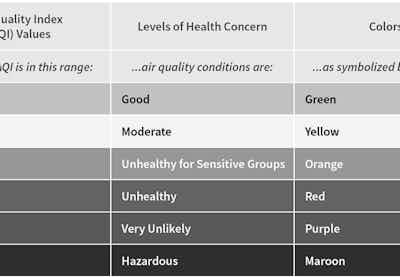In the late 1960s, U.S. EPA developed the original Air Quality Index, or’ AQI scale’, to make the public health impacts of air pollution concentrations easily understandable.
The Air Quality Index, or AQI, is much like an air quality "thermometer", translating daily air pollution concentrations of key pollutants into a number divided into six color-coded ranges, with numbers 0-500, based on the National Ambient Air Quality Standards (NAAQS). The six pollutants are ozone, carbon monoxide, nitrogen dioxide, sulfur dioxide, and two sizes of particulate matter.
The US EPA AQI is used to simplify ambient pollutant concentrations (measured or modelled) into pollutant indices based on the National Ambient Air Quality Standards (NAAQS). These indices are then evaluated to form a single total air quality index.
Calculating the AQI remains anchored on the NAAQS criteria, which vary between 1 and 24 hours in averaging time, depending on the pollutant. This can be problematic in cases where the public needs immediate warning that changes are occurring, e.g. in the event of a wildfire.
In the US and elsewhere in the world, real-time monitoring of air quality with rapid updates is becoming the norm. To accommodate this shift in monitoring technologies and data formats, so-called ‘real time’ AQI values have been developed, based on a complex weighted average of recent hours of data. The methods used are still, however, anchored on the NAAQS standards, and so do not fit perfectly with a dynamic real-time monitoring system. For example, air districts such as the BAAQMD are using hourly PM2.5 monitoring data to provide an hourly AQI for PM 2.5 but they do note that the US EPA AQI for PM2.5 is based on 24-hour concentrations, so hourly readings are only estimates only.

Figure 1: Example of AQI. “Good (between 0 and 50), Moderate (between 51 and 100) and Unhealthy for Sensitive Groups (between 101 and 150) etc.” Image Sourced from USEPA website.
Over the past two decades, the ‘AQI’ concept has been adopted throughout the world in various ways, so that an ‘AQI’ is not based on the same approach everywhere. This is potentially confusing.
For example, to accommodate short-term measurements, the European approach includes the hourly CAQI (Common AQI) which is based on 1-hour average concentration values.
These values are based on adjustments to air quality standards that in some cases apply for longer averaging times (e.g. 24 hours for PM). Hence, we are best to regard the concentration values used in calculating the CAQI as ‘indicators’ rather than ‘standards’. The CAQI works on a scale of 0-100, whereas the US AQI is on a scale of 0-500.
AQI and reaction to sudden air pollution events
It could be argued that the CAQI is less ‘conflicted’ by the need to strictly adhere to the traditional approach. By comparison, the US EPA AQI value varies daily, calculated from previous time steps, based on an agreed methodology and the legislated NAAQS. The US ‘real-time AQI’ is somewhat of a hybrid solution.
We know from experience, e.g., large wildfire events, that the air quality can change rapidly and drastically. This makes the AQI incapable of reacting fast enough in some instances, which may in fact have the greatest potential health impacts.
Envirosuite has the capability to track and predict air quality changes over short periods and we are looking into ways of improving how simple measures of air quality like the CAQI can be further developed and applied.
